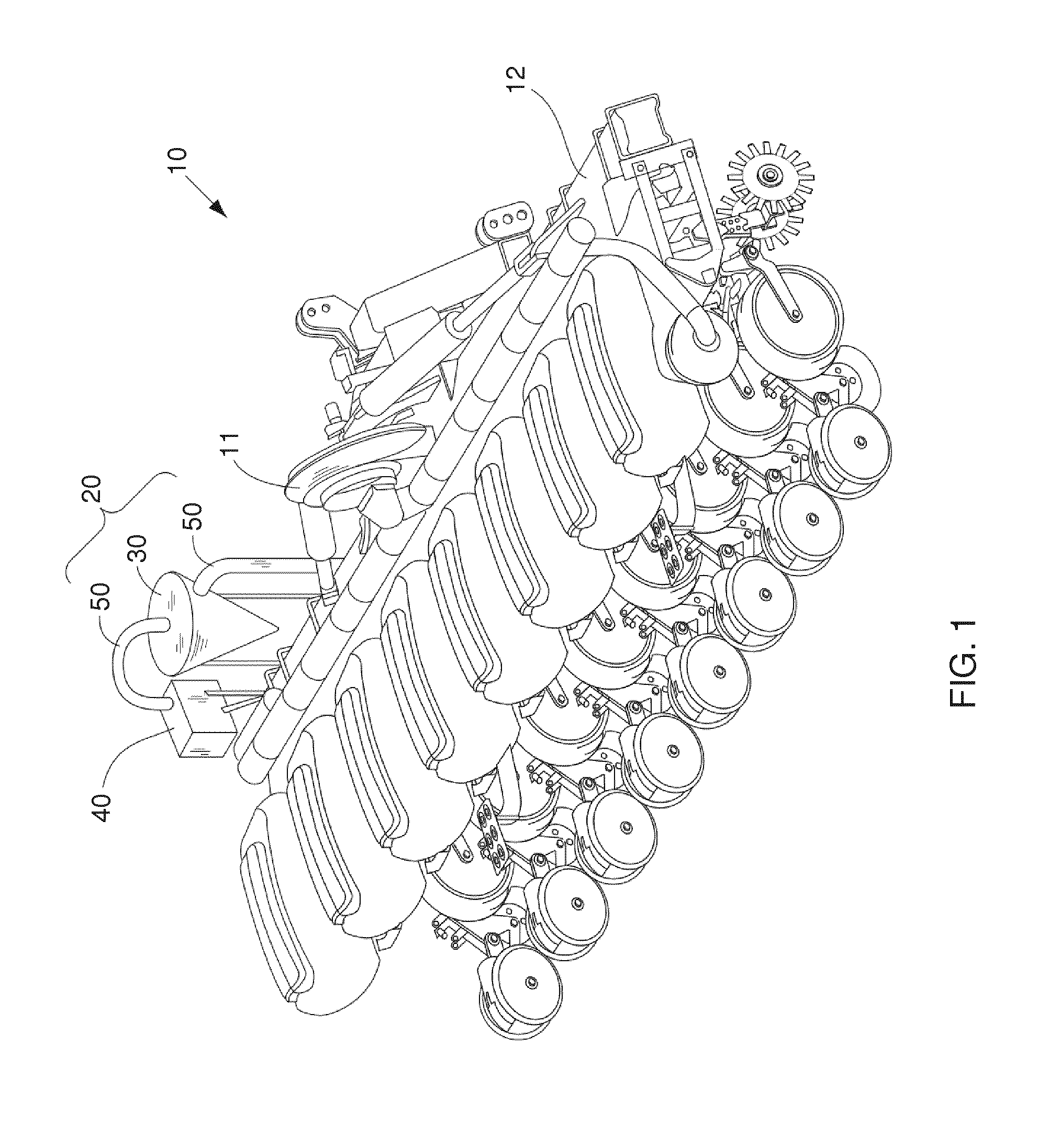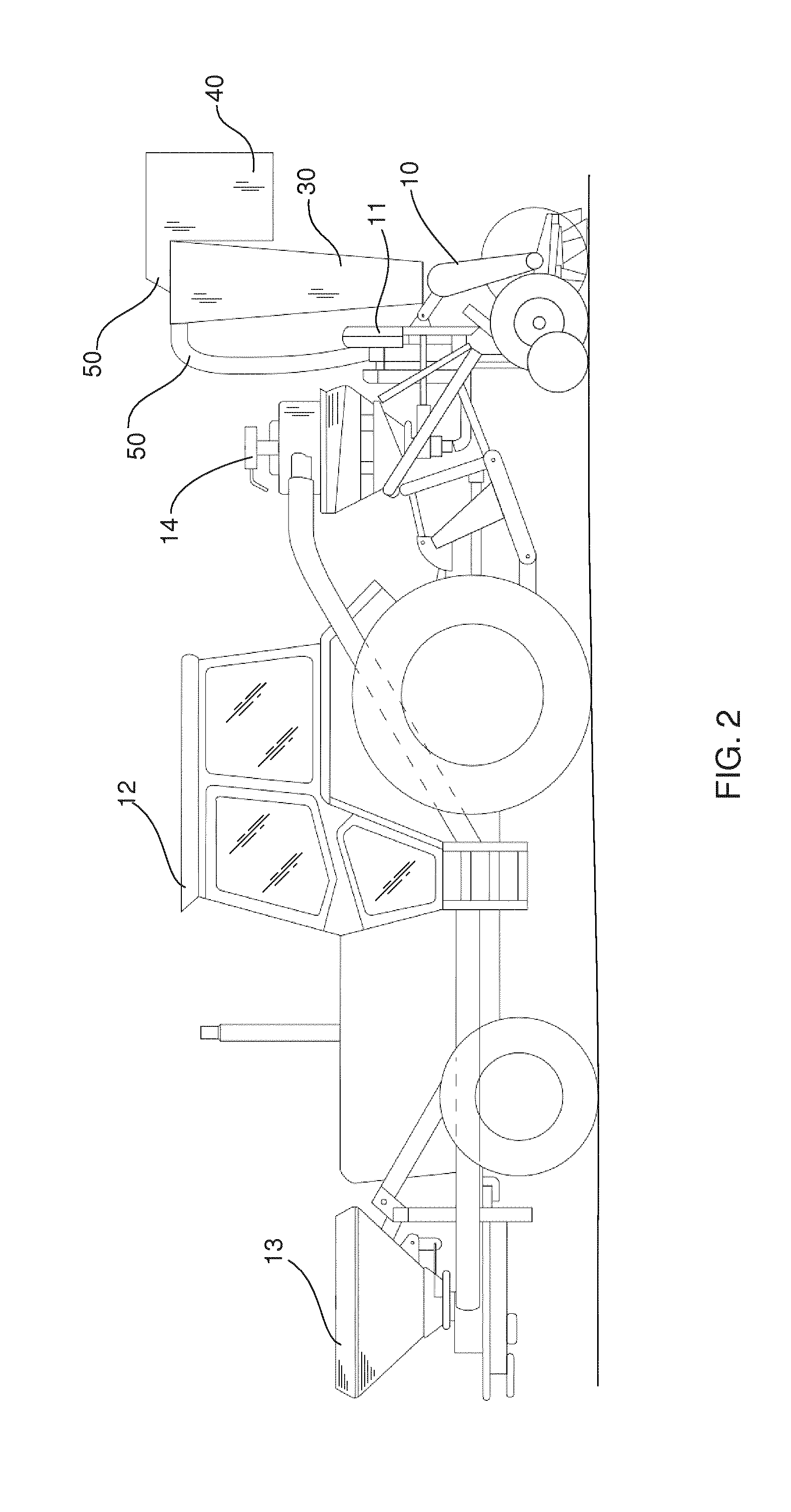Planter Exhaust Air Removing Apparatus and Method of Use Thereof
a technology of planter and exhaust air, which is applied in the direction of separation process, single grain seeder, dispersed particle separation, etc., can solve the problems of unsuitably cleaned untreated seeds, unfavorable treatment of untreated seeds, and generating dust and debris, so as to reduce the amount of material requiring disposal, reduce the amount of airflow, and reduce the effect of airflow
- Summary
- Abstract
- Description
- Claims
- Application Information
AI Technical Summary
Benefits of technology
Problems solved by technology
Method used
Image
Examples
example 1
Evaluation of a First Embodiment
[0059]An experiment was conducted to evaluate the performance of an embodiment of the particle removing apparatus of the invention. 140 kg of maize seeds were treated using a WN 5 rotostat treater (Willy Niklas GmbH Apparatebau, Germany) with a conventional seed treatment product (CRUISER insecticide, Syngenta Crop Protection AG, Switzerland; MAXIM XL fungicide, Syngenta Crop Protection AG; SEPIRET 9290 pigment, Becker Underwood, France) according to standard rates and procedures. After drying the seeds were placed in a vacuum planter (MONOSEM 8 rows, MONOSEM, France) and drilled in a field at standard speed using standard techniques.
[0060]All of the exhaust air from the vacuum planter turbine was channeled to a cyclonic separator via a flexible hose. The cyclonic separator was provided in a cylindrical outer housing and having a detachable base. The cyclonic separator was fixed to the planter near the turbine and between seed hoppers.
[0061]All of the...
example 2
Evaluation of a Second Embodiment
[0067]Maize seeds were provided in a manner similar to Example 1. The cyclonic separator was provided with a length along the central axis being multiples of the width of the cyclonic separator. This was intended to result in a greater proportion of particles captured in the cyclonic separator as opposed to the filter unit. The cyclonic separator was fixed to the planter behind (referring to the direction of travel of the planter in use) the turbine and between seed hoppers. All of the exhaust air from the cyclonic separator was channeled to a filter unit via a fixed connection. The filter unit was the form of a metal housing fitted with a fine dust pocket filter (0.5 micron particle size, 820 m3 / hour maximum air flow, 2.1 m2 active filter surface area, UNIFIL AG, Switzerland). The filter unit was fixed to the cyclonic separator as a single apparatus.
[0068]In order to simulate the most demanding conditions one would expect in use, the trial was condu...
example 3
Further Evaluation of a Second Embodiment
[0071]Maize seeds were provided in a manner similar to Example 1. The cyclonic separator was provided and operated according to Example 2
[0072]A trial was conducted under dry soil conditions. A total of 23 Ha were planted and at the end of the trial the particles collected in the cyclonic separator and filter unit were weighed. Results are shown in Table 3.
TABLE 3Collected Particles (g)Collected Particles (g / Ha)TrialCyclonic SeparatorFilter UnitCyclonic SeparatorFilter Unit432841581376.6
[0073]The observation in trial 4 that the cyclonic separator gathered 95.4% of the particulate matter, and that the remaining 4.6% were caught in the filter, further demonstrated that the combination of cyclonic separator and particulate filter give an effective particulate removal process.
PUM
| Property | Measurement | Unit |
|---|---|---|
| Area | aaaaa | aaaaa |
Abstract
Description
Claims
Application Information
 Login to View More
Login to View More - R&D
- Intellectual Property
- Life Sciences
- Materials
- Tech Scout
- Unparalleled Data Quality
- Higher Quality Content
- 60% Fewer Hallucinations
Browse by: Latest US Patents, China's latest patents, Technical Efficacy Thesaurus, Application Domain, Technology Topic, Popular Technical Reports.
© 2025 PatSnap. All rights reserved.Legal|Privacy policy|Modern Slavery Act Transparency Statement|Sitemap|About US| Contact US: help@patsnap.com



